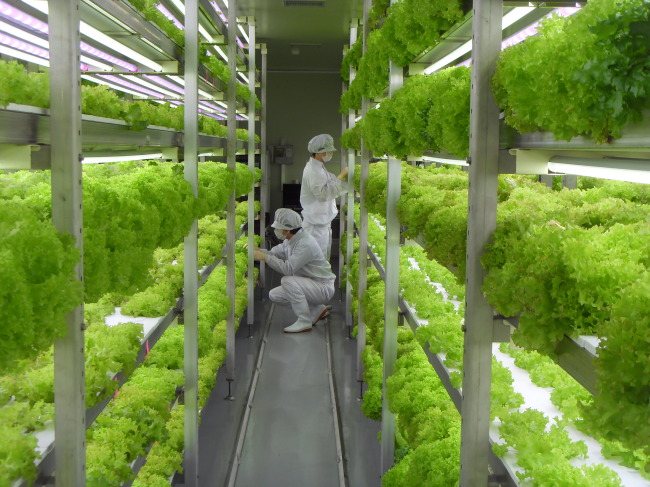A dystopian take on the Hanging Gardens of Babylon is among many eye-catchers in “Snowpiercer,” a futuristic epic directed by Bong Joon-ho.
In a train split by the privileged front passengers and low-class tail inhabitants, rebels break into a verdant greenhouse railcar in the middle section. It houses a variety of plants, fruits and vegetables for the elite as part of the self-sustaining ecosystem of the train.
That is no more just in sci-fi. A farm in Yongin on the outskirts of Seoul is ripe with rows of romaine and lollo lettuce and other salad greens growing not from the earth, but on plastic shelves inside a seven-story office building.
The “vertical farm,” run by Insung Tech, cultivates indoor crops by artificially supplying air, water, light, minerals and other necessary conditions for plants to grow.
In a train split by the privileged front passengers and low-class tail inhabitants, rebels break into a verdant greenhouse railcar in the middle section. It houses a variety of plants, fruits and vegetables for the elite as part of the self-sustaining ecosystem of the train.
That is no more just in sci-fi. A farm in Yongin on the outskirts of Seoul is ripe with rows of romaine and lollo lettuce and other salad greens growing not from the earth, but on plastic shelves inside a seven-story office building.
The “vertical farm,” run by Insung Tech, cultivates indoor crops by artificially supplying air, water, light, minerals and other necessary conditions for plants to grow.

This new type of urban farming has emerged in recent years in the face of simmering food security concerns, loss of arable land and reduced access to fresh water, all propelled by global warming.
Inside Insung’s artificial farm, surrounded by large apartment complexes and office buildings, the green leaves flourish with their roots soaking in a little soil infused with nutrient-rich water below plastic molds on the shelves.
The method takes a lot less land, labor and chemical input than traditional farming. The facilities were designed to mimic the natural ecosystem by adopting light-emitting diode lamps, solar panels and recycled water.
“Now we offer not just the vegetables but also minifarms with which customers can grow the plants at home, improve the indoor environment and teach their kids about nature,” chief executive Kim In-soo told The Korea Herald.
Insung, formerly a manufacturer of self-service car wash equipment founded in 1991, transformed into an agriculture pioneer in 2009.
The concept of integrating agriculture into a man-made environment was invented in a Danish farmhouse back in the 1950s that attempted to grow cress ― a peppery, tangy-flavored herb related to mustard ― in a factory on a large scale.
Scientists say the combination of agriculture and high technology can enable year-round crop harvests even in the most arid areas while minimizing environmental damage.
Dickson Despommier, a Columbia University professor who introduced the idea of growing food in skyscrapers in 1999, claims a 30-story vertical farm can feed up to 50,000 people a year.
In line with the growth of the industry, Insung has managed to curtail high facility costs and boost profitability. It has also developed special LED lamps that are more efficient and last longer than regular ones available on the market, Kim said.
The company is seeking to expand to other countries. Clients from regions with harsh climates, including Norway, Russia and the Middle East, have shown interest, he said.
“Compared with when we set out, the unit price has sharply gone down,” Kim said. “We can produce what a 1,300-square-meter greenhouse would do in a 200-square-meter area with the initial facility cost hovering around just 200 million won ($187,000).”
By Shin Hyon-hee (heeshin@heraldcorp.com)
-
Articles by Korea Herald





![[Herald Interview] 'Amid aging population, Korea to invite more young professionals from overseas'](http://res.heraldm.com/phpwas/restmb_idxmake.php?idx=644&simg=/content/image/2024/04/24/20240424050844_0.jpg&u=20240424200058)












![[KH Explains] Korean shipbuilding stocks rally: Real growth or bubble?](http://res.heraldm.com/phpwas/restmb_idxmake.php?idx=652&simg=/content/image/2024/04/25/20240425050656_0.jpg&u=)

